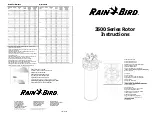
Model 8340A - Service
In Bands 1-4 the SYTM is designed to pass only the RF output frequency and reject all other
frequencies. In Band
'O,
the output of the Band 0 mixer passes directly through the SYTM.
To troubleshoot for harmonics and sub-harmonics in Band 0 (10 MHz to 2.3 GHz), refer to
the RF Block Diagram and troubleshoot the Band 0 circuitry using a spectrum analyzer.
For Bands 1-4 the SYTM is designed to pass only the fundamental or desired harmonic of the
YO. If the instrument does not meet its harmonic/sub-harmonic specification, suspect the
SYTM.
LINE RELATED SIDEBANDS
Line related spurs are normally caused by magnetic radiation from the power transformer
being coupled into the M/N Loop, the Reference Oscillator, or the SYTM.
The amplitude of any line related spur coupled into the M/N Loop will be greater at 6.9 GHz
(maximum M/N Loop frequency). The amplitude of any line related spur coupled into the
SYTM will be greater at 2.3 GHz (minimum SYTM drive current).
An increase in line voltage or the line voltage selector PC board installed incorrectly may
increase the radiation and thus the spur amplitude ..
Check the waveform on the unregulated power supplies. These supplies have full-wave
bridge rectifiers. If one diode is open; the supply will operate similar to a half-wave rectifier.
The output of the regulated supplies may be normal. However, the transformer current will
be unbalanced and the magnetic radiation may increase.
Magnetic radiation coupled into the M/N Loop can sometimes be reduced by replacing
A2 9Ul (The amplifier limiter on the Reference Phase Detector board).
SQUEGGING (Band 1-4 only)
Observe the spurious response on a spectrum analyzer while changing the HP 8340A output
power level. If the frequency of the spur changes with power level, suspect squegging. Refer
to the SRD Bias adjustments in Section
V.
SYNTHESIZED SPURS
NOTE
The screws on the 20/30 and M/N section covers must be tight to
obtain proper shielding.
Explanation of synthesized spurs - A frequency synthesizer like the HP 8340A has several
internal o.scillators that are used to generate the desired output frequency. All of the output
frequencies that are possible can be described by the following equation:
Fout = kl *Fl
+
k2*F2
+
k3*F3 ........... .
where kl , k2, and k3 are integers (positive or negative) and Fl, F2, and F3 are the frequencies
of the internal oscillators. Since Fl, F2, and F3 are phase locked to the internal reference (10
MHz standard) they will be related to the reference frequency by:
Fl = Ref*Il/Jl F2 = Ref*I 2/J2 F3 = Ref*I 3/J3
where the I's and J's are integers. The combination of all these shows the relationship of the
output frequency to the refere·nce frequency:
Fout= Ref * (kl*Il/Jl
+
k2*I2/J2
+
k3*13/J3 ... )
The intended output frequency is the result of only one set of integers in the above equation.
Spurs are possible at all other choices of integers. These choices are normally eliminated
through careful use of filtering, attention to signal levels, shielding, etc.
8-51
Scans by HB9HCA and HB9FSX
Содержание 8340A
Страница 1: ...Scans by HB9HCA and HB9FSX ...
Страница 113: ...Scans by HB9HCA and HB9FSX ...
Страница 187: ...Scans by HB9HCA and HB9FSX ...
Страница 198: ...Scans by HB9HCA and HB9FSX ...
Страница 269: ...Scans by HB9HCA and HB9FSX ...
Страница 296: ...Scans by HB9HCA and HB9FSX ...
Страница 320: ...Scans by HB9HCA and HB9FSX ...
Страница 321: ...Scans by HB9HCA and HB9FSX ...
Страница 322: ...Scans by HB9HCA and HB9FSX ...
Страница 323: ...Scans by HB9HCA and HB9FSX ...
Страница 324: ...Scans by HB9HCA and HB9FSX ...
Страница 325: ...Scans by HB9HCA and HB9FSX ...
Страница 326: ...Scans by HB9HCA and HB9FSX ...
















































